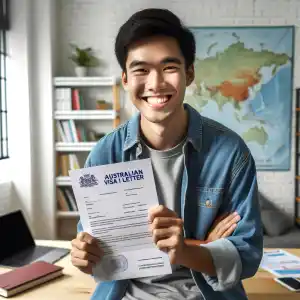Understanding the Partner (Provisional) Visa Subclass 309

What is the Partner (Provisional) Visa (Subclass 309)?
The Partner (Provisional) Visa, known as Subclass 309, is a temporary visa designed for the spouse or de facto partner of an Australian citizen, Australian permanent resident, or eligible New Zealand citizen. It is the first step towards obtaining permanent residency through the Partner visa (subclass 100). This visa allows individuals to live in Australia and build their life with their partner, with the intent of transitioning to permanent residency.
Purpose of the Subclass 309 Visa
The primary purpose of the Subclass 309 visa is to unite partners while their application for a permanent Partner visa (subclass 100) is processed. It acknowledges the importance of allowing couples to live together in Australia and offers a pathway to permanent residency reflecting the commitment of the relationship.
Temporary Nature of the Visa
Subclass 309 is a provisional visa, meaning it's granted on a temporary basis. It allows the applicant to stay in Australia temporarily until a decision is made on their permanent Partner visa (subclass 100) application or if the application is withdrawn. The temporary status of this visa permits applicants to start integrating into Australian society and establish their life with their partner.
Pathway to Permanent Residency
Holding a Subclass 309 visa is a prerequisite for the permanent Partner Visa (subclass 100). It sets the foundation for applicants to prove their relationship's genuineness and continuity. After a specified period, and upon meeting all the necessary criteria, individuals on a Subclass 309 visa can apply for the Subclass 100 visa, leading to permanent residency in Australia.
Key Features of the Subclass 309 Visa
- Live in Australia: Applicants are allowed to live in Australia temporarily while they await the decision on their permanent Partner visa application.
- Work and Study: There are no restrictions on work or study, allowing visa holders to work and study in Australia.
- Travel Rights: The visa comes with multiple travel rights, allowing individuals to travel to and from Australia until a decision is made on their permanent visa.
- Medicare Access: Applicants may be eligible for Medicare, Australia's public healthcare scheme, providing access to health care services.
- Preparation for Permanent Residency: This visa is a crucial step in the journey towards becoming permanent residents and eventually citizens of Australia.
Importance of the Visa
The Partner (Provisional) Visa is an important component of Australia's family immigration stream. It demonstrates Australia's commitment to family unity and provides a legitimate and practical pathway for partners of Australians to build a life together in Australia. It also ensures that relationships are genuine and stable before granting permanent residency, aligning with Australia's immigration integrity measures.
In summary, the Partner (Provisional) Visa (Subclass 309) is not just a document granting temporary residence; it's a pathway to a shared future in Australia for international couples. It allows partners to live, work, and prepare for their permanent life together in Australia, strengthening personal and community ties and contributing to the multicultural fabric of Australian society.
Section 2: Eligibility Criteria
Relationship Status
- Married Applicants: If you are married, your marriage must be legally valid under Australian law. This means your marriage should be recognized in the country where it was solemnized and in Australia. You need to demonstrate a mutual commitment to a shared life as husband and wife to the exclusion of all others.
- De Facto Partners: De facto partners must prove that they have been in a genuine and continuing relationship for at least 12 months immediately before applying. The relationship must be exclusive, genuine, and continuing. You must not be related by family and must have a mutual commitment to a shared life together. Exceptions to the 12-month rule apply if there are compelling and compassionate circumstances, or the relationship has been registered in a state or territory of Australia.
Sponsorship
- Requirement of a Sponsor: You must be sponsored by your partner, who is an Australian citizen, Australian permanent resident, or eligible New Zealand citizen. Your sponsor needs to be approved by the Australian Government and should be willing to support you for the first two years of your stay in Australia.
- Sponsor's Commitment: The sponsor must provide a written statement pledging to support you during your initial years in Australia. This includes financial and accommodation support if necessary.
Location at the Time of Application
- Outside Australia: You must be outside Australia when you apply for the Subclass 309 visa. This requirement ensures that the visa process is consistent and fair, considering the provisional nature of the visa and its pathway to permanent residency.
Health and Character Requirements
- Health Checks: You must meet certain health standards to ensure that you do not pose a threat to public health and that you will not cause excessive demand on the Australian health care system. This typically involves undergoing a medical examination by a doctor approved by the Australian Government.
- Character Assessment: A good character is a must for entering Australia. This involves police checks and possibly providing police certificates from any country you have lived in for 12 months or more over the last ten years since turning 16.
Debts to the Australian Government
- No Outstanding Debts: You must have no outstanding debts to the Australian Government or have arranged to repay any outstanding debts.
Best Interests of the Child
- Protecting Children: The Australian Government must consider the best interests of any children involved in your application. This means that if granting the visa is not in the best interests of a child, particularly in cases of custody or welfare concerns, the visa may not be granted.
Additional Eligibility Points
- No Previous Visa Cancellations or Refusals: If you have had a visa cancelled or a previous application refused while in Australia, you might face difficulties in being granted a new visa.
- Age Requirements: Generally, both partners need to be 18 years or older, recognizing the legal age for marriage in Australia.
Relationship Proof
- Evidence of Relationship: You need to provide evidence of your relationship with your partner. This includes but is not limited to, joint bank account statements, billing accounts in both names, and other evidence of shared commitments and life together. For married couples, a marriage certificate is needed. For de facto relationships, evidence of the genuine and continuous nature of the relationship is required.
By meeting these criteria, you demonstrate to the Australian government that your relationship is genuine and stable, and that you are committed to building a life together in Australia. It's important to provide accurate and complete information when applying, as any discrepancies or lack of evidence can lead to visa refusal. Always keep updated with the latest Australian immigration laws and policies, as they can change and affect your eligibility.
Section 3: Application Process
Step-by-Step Guide on How to Apply
- Check Your Eligibility: Before applying, ensure that you meet all the criteria under Section 2. Understand the relationship requirements, sponsorship obligations, and ensure you are outside Australia at the time of application.
- Gather Necessary Documents: Compile all required documents, including proof of relationship, identity documents, health and character checks, and any other relevant information. This may include marriage certificates, joint bank statements, photographs together, and written statements about the relationship.
- Health and Character Assessments: Arrange for your health examinations with a panel physician approved by the Australian government and obtain police clearance certificates from every country you've lived in for 12 months or more in the past ten years.
- Complete the Application: Fill in the online application form for the Subclass 309 visa. Ensure all the information is accurate and that the form is fully completed before submission.
- Sponsorship Application: Your partner must also submit a sponsorship application on your behalf. This involves them accepting legal responsibilities for you during your initial years in Australia.
- Pay the Application Fee: Pay the required visa application charge. This fee is non-refundable, even if the visa application is unsuccessful or withdrawn.
- Submit the Application: Once all the details are filled in and all necessary documents are attached, submit the application. Ensure you keep a copy of the receipt and note down the transaction reference number.
- Attend an Interview (if required): In some cases, you or your sponsor may be asked to attend an interview. Be honest and consistent in your responses.
- Provide Additional Information if Requested: Sometimes, you might be asked to provide additional information or go through further health checks. Respond promptly to any such requests.
- Wait for Decision: After submission, you will need to wait for the decision. The processing times can vary, so it's important to be patient.
- Visa Outcome: You will be informed of the decision on your visa application. If granted, you will receive details of your visa, including your visa grant number, the date your visa starts, and any visa conditions.
Documents Required for the Application
- Identity Documents: Birth certificate, passport pages, national identity card, and any change of name documents.
- Relationship Evidence: Marriage certificate, joint bank account statements, rental agreements, and any other documents proving the nature of your relationship.
- Health Exams: Results from health examinations.
- Character Assessments: Police certificates from every country lived in for 12 months or more in the past ten years.
- Sponsorship Documents: Proof of your partner's Australian citizenship, permanent residency, or eligible New Zealand citizenship.
Tips for a Successful Application
- Complete and Accurate Information: Ensure all information provided is complete, accurate, and truthful.
- Quality of Documents: Provide clear, high-quality copies of all documents. Ensure translations are certified if they are not in English.
- Follow Instructions: Carefully follow all instructions provided for the application process, including specific guidelines for photographs, document size, and format.
- Stay Informed: Keep up to date with any changes in the visa policy or processing guidelines that may affect your application.
- Seek Professional Help if Needed: If you're unsure about any aspect of the application, consider consulting with a registered migration agent or legal practitioner.
Remember, the success of your application heavily depends on the completeness and accuracy of the information provided. Double-check all entries and ensure that you have addressed all requirements before submitting your application. Keep a keen eye on communication from the Department of Home Affairs and respond promptly to any requests for additional information or clarification.
Section 4: Visa Features and Benefits
Live in Australia
- Temporary Residence: As a Subclass 309 visa holder, you are allowed to live in Australia temporarily while awaiting the decision on your permanent Partner visa (subclass 100).
- Integration Opportunity: This visa provides an opportunity to integrate into Australian society, get accustomed to the Australian way of life, and establish a home with your partner.
Work and Study in Australia
- Work Rights: You have the right to work in Australia without restrictions, which means you can undertake any form of lawful employment. This helps you support yourself and your family and gain local work experience.
- Study Rights: While you can study in Australia, it's important to note that you will not have access to government funding for tertiary education and might need to pay international student fees.
Travel to and from Australia
- Multiple Travel Rights: The visa allows you to travel to and from Australia freely until a decision is made on your permanent Partner visa. This means you can visit your home country or any other country and return to Australia as long as your visa is valid.
Access to Medicare
- Healthcare Eligibility: Depending on your circumstances, you may be eligible to enroll in Medicare, Australia's public healthcare scheme. This gives you access to healthcare services at a lower cost and sometimes for free, offering significant support and peace of mind during your stay.
Preparation for Permanent Residency
- Pathway to Permanent Residency: Holding a Subclass 309 visa is the first step towards obtaining a permanent Partner visa (subclass 100). It allows you time to gather further evidence of your relationship's genuineness and continuity, which is crucial for your permanent residency application.
- Stability and Planning: Knowing that you have a pathway to permanent residency allows you and your partner to make long-term plans in Australia, including career development, education, and family planning.
Community and Language Support
- Adult Migrant English Program (AMEP): You might be eligible for free English language classes provided by the Adult Migrant English Program, helping you improve your language skills and better integrate into Australian society.
Other Considerations
- Contributing to Australia: As a Subclass 309 visa holder, you are encouraged to contribute to your local community, whether through employment, volunteering, or other community activities. This involvement can enrich your experience and help build connections.
- Understanding Your Rights and Responsibilities: It's important to understand both your rights and responsibilities as a visa holder, including adhering to Australian laws and regulations, and ensuring that you remain compliant with your visa conditions.
In summary, the Partner (Provisional) Visa (Subclass 309) offers significant benefits and features that allow you and your partner to start building a life together in Australia. It provides the necessary rights to work and study, as well as the opportunity to travel, access healthcare, and prepare for a future permanent residency in Australia. Being aware of and utilizing these features can greatly enhance your experience and ensure a smooth transition to your new life in Australia.
Section 5: Costs and Processing Times
Costs of the Subclass 309 Visa
- Visa Application Charge: The main cost involved in applying for the Subclass 309 visa is the visa application charge, which is required for processing your application. As of the latest update, the cost starts from AUD 8,850.00 for the main applicant. It's crucial to check the most current fee on the official Department of Home Affairs website as fees can be updated annually or due to policy changes.
- Additional Applicant Charges: If you include family members in your application, such as dependent children, there are additional charges for each person. These costs contribute to the processing and assessment of each individual included in the application.
- Health Examinations and Police Checks: Applicants are responsible for the costs of their health examinations and obtaining police checks from every country they've lived in for 12 months or more over the past ten years. These costs vary by country and provider.
- Other Possible Costs: Additional costs may include professional fees if you hire a migration agent or attorney, translation services, certification of documents, or courier fees for sending documents.
Processing Times
- General Processing Information: Processing times for the Partner (Provisional) Visa (Subclass 309) can vary significantly based on individual circumstances, the completeness of the application, and the current demand for visas. It's important to note that processing times are influenced by the volume of applications received, the complexity of individual cases, and how promptly applicants provide required information.
- Estimated Processing Times: The Department of Home Affairs provides general processing time frames based on recent data. As of the latest information, it's common for this visa to take anywhere from several months to a couple of years to process. Applicants should use the visa processing time guide tool available on the Department's website for the most accurate and up-to-date information.
- Factors Affecting Processing Times:
- Volume of Applications: High demand can lead to longer processing times.
- Completeness of Application: Incomplete applications or those with errors can face significant delays.
- Response Times: How quickly you respond to any requests for additional information.
- Complex Cases: If there are complex aspects to your situation, such as custody issues or health concerns, additional time may be needed to assess your application.
Strategies to Potentially Reduce Processing Times
- Complete and Accurate Application: Ensure all sections of the application are filled out accurately and that all necessary supporting documents are included. Incomplete applications can be delayed or, in some cases, refused.
- Early Health and Character Assessments: Undergo your health examinations and obtain your police checks as soon as possible to avoid delays later in the process.
- Stay Informed and Responsive: Keep up to date with any correspondence from the Department of Home Affairs and respond promptly to any requests for additional information.
- Consult Professionals: If unsure about any part of the application process, consider seeking advice from a registered migration agent or legal practitioner to ensure your application is as strong and complete as possible.
In summary, while you can't control all factors affecting processing times, ensuring a complete and accurate application, being proactive about health and character requirements, and staying responsive can help make the process as smooth as possible. Keep in mind that patience is often necessary, as immigration processes can take time due to the meticulous nature of checks and verifications involved.
Section 6: After You Apply
What Happens After Submission
- Acknowledgment of Receipt: After submitting your application for the Subclass 309 visa, you should receive an acknowledgment from the Department of Home Affairs. This acknowledgment will confirm that they have received your application and it is being processed.
- Application Processing: Your application will enter a queue to be processed by the immigration officers. During this time, they will assess the information and documents you provided, conduct background checks, and determine your eligibility for the visa.
- Additional Information Requests: If the Department needs more information or clarification, they will contact you or your migration agent. This might include requests for additional documents, more details about your relationship, or clarification of the information provided.
- Health and Character Assessments: If you haven't already, you may be instructed to complete health examinations and provide police certificates. The department will guide you on how to complete these steps.
- Visa Decision: Once all necessary information has been assessed, a decision will be made on your visa application. The Department of Home Affairs will notify you of the outcome.
Communicating Changes
- Update Your Details: If there are any changes to your circumstances or contact details after you have applied, it's important to inform the Department immediately. This includes changes in address, passport details, or family circumstances.
- Adding Family Members: If you have had a child or need to add a dependent after you have lodged your application, you must inform the Department and provide the necessary documents for the new dependant.
If You Need to Travel
- First Entry Date: If you are outside Australia at the time of visa grant, you'll be given a 'first entry date' by which you need to enter Australia. Ensure that you comply with this requirement.
- Traveling Before Decision: If you need to travel to Australia before your visa decision is made, you might need to apply for another type of visa to enter Australia temporarily. Be aware that the new visa might have conditions that could impact your Partner visa application.
If Your Relationship Ends
- Informing the Department: If your relationship ends while your application is being processed, you must inform the Department as soon as possible. The breakdown of your relationship can affect your eligibility for the Partner visa.
Preparing for Visa Grant
- Planning Your Move: Start planning your move to Australia, including where you'll live, work, and other settlement considerations.
- Understand Visa Conditions: Be aware of any conditions that will be attached to your visa and understand what is required to comply with these conditions.
After Visa Grant
- Enter Australia: Make arrangements to enter Australia before the specified first entry date.
- Comply with Visa Conditions: Ensure that you understand and comply with all visa conditions. This can include not working until a certain date, informing the department of changes in circumstances, or maintaining health insurance.
- Prepare for Permanent Residency: Start gathering evidence and documents for your permanent Partner visa (subclass 100) application, including continued proof of your relationship and other criteria as specified by the Department of Home Affairs.
Remember, the process doesn't end with the submission of your application. Staying informed, responding to requests promptly, and preparing for the next steps are crucial to ensuring a smooth transition to life in Australia under the Subclass 309 visa. Always keep communication open with the Department of Home Affairs and consult their official website or a registered migration agent for the most accurate and up-to-date advice.
Section 7: Preparing for the Permanent Partner Visa (Subclass 100)
After you have been granted the Subclass 309 visa, the next step in your journey is to prepare for the transition to the permanent Partner Visa (subclass 100). This stage is crucial as it involves demonstrating the ongoing and genuine nature of your partnership. Here are some key considerations and steps to prepare for your application for the permanent Partner Visa.
Understanding the Timeline
- Two-Year Waiting Period: Generally, there is a waiting period of two years from the time you lodged your initial Partner visa application (Subclass 309). This period allows you time to establish your relationship further and gather evidence of your commitment.
- Notification from the Department: As you approach the end of this period, the Department of Home Affairs will typically contact you to start the process for the permanent visa. However, it's important to be proactive and keep track of the dates yourself.
Continuous Relationship Evidence
- Gathering Documentation: Continue to collect evidence of your relationship, including joint financial documents, lease or mortgage agreements, travel documents, photographs, and other evidence that demonstrates you and your partner are living together and sharing a life.
- Statutory Declarations: You may need updated statutory declarations from friends or family members attesting to the genuine and continuing nature of your relationship.
- Significant Changes: Document any significant changes or milestones in your relationship, such as the birth of children, major joint purchases, or shared experiences.
Legal and Health Requirements
- Health Assessments: You may need to undergo further health assessments if your last health check is no longer valid or if there have been changes to your health situation.
- Police Checks: Update your police checks if the previous ones are no longer current or if you have lived in a different country since your last check.
- Consultation with Legal Professionals: Consider consulting with a migration agent or legal professional to ensure that you understand the current regulations and requirements for the permanent visa application.
Application for the Subclass 100 Visa
- Filling Out the Application: Complete the necessary forms and provide all the required documentation. Ensure that every piece of information is up-to-date and accurate.
- Application Fee: Be prepared to pay any necessary application fee for the permanent visa. Like the Subclass 309 visa, this fee is typically non-refundable, regardless of the decision on your application.
- Joint Statements: Prepare a statement with your partner detailing how your relationship has continued and developed since you were granted the Subclass 309 visa.
Staying Informed and Compliant
- Stay Informed: Immigration laws and policies can change. Regularly check for any updates that might affect your eligibility or the documentation required for the permanent Partner Visa.
- Maintain Legal Status: Ensure that you continue to comply with the conditions of your Subclass 309 visa while you await the decision on your permanent visa application.
- Engage with Communities: Continue to engage with local communities, work, and possibly volunteer. Building a life in Australia shows your commitment to residing in the country and can be beneficial for your application.
Preparing for the Future
- Long-term Plans: Start thinking about long-term commitments like purchasing property, long-term employment, and education for any children. These aspects of a shared life can further demonstrate the genuine nature of your relationship.
The transition from a provisional to a permanent partner visa is a significant step in your journey to becoming a permanent resident of Australia. It's a period to strengthen your relationship and continue building a shared life in Australia. By preparing thoroughly, staying informed, and ensuring compliance with all requirements, you can smoothly navigate this process and look forward to a future in Australia with your partner.
Section 8: FAQs
This section addresses common questions and concerns about the Partner (Provisional) Visa (Subclass 309) and its application process. It aims to clarify doubts and provide applicants with a better understanding of what to expect.
Q1: How long does the Subclass 309 visa allow me to stay in Australia?
A1: The Subclass 309 visa is a temporary visa that allows you to stay in Australia until a decision is made on your permanent Partner visa (subclass 100) application or if you withdraw your application. It's typically valid until the processing of the Subclass 100 visa is complete.
Q2: Can I work in Australia on a Subclass 309 visa?
A2: Yes, you are allowed to work in Australia on a Subclass 309 visa. There are no restrictions on the type of work or the number of hours you can work. This enables you to support yourself and contribute to the Australian community while waiting for your permanent visa.
Q3: What happens if my relationship ends before I obtain permanent residency?
A3: If your relationship ends before you are granted a permanent visa, you must inform the Department of Home Affairs immediately as it can affect your eligibility for the permanent Partner visa (subclass 100). In some circumstances, you may still be eligible for the visa if certain criteria are met, such as having children in the relationship or if there was family violence.
Q4: How do I prove my relationship is genuine and ongoing?
A4: You need to provide various forms of evidence that demonstrate your relationship is genuine and ongoing. This includes but is not limited to joint financial documents, photographs together, communication records, statutory declarations from friends and family, and any other evidence that shows you and your partner live together and share a life.
Q5: Are there any travel restrictions on the Subclass 309 visa?
A5: The Subclass 309 visa typically allows you to travel to and from Australia freely until a decision is made on your permanent Partner visa. However, you should always check the specific conditions on your visa grant notice as circumstances can vary.
Q6: Can I include my children in my Subclass 309 visa application?
A6: Yes, you can include dependent children in your Subclass 309 visa application. Each dependent will need to meet certain requirements and will be subject to additional application charges. Ensure all children included in the application meet the definition of 'member of the family unit' as per the immigration regulations.
Q7: What are the main reasons a Subclass 309 visa application might be refused?
A7: Common reasons for refusal include insufficient evidence of the relationship, failure to meet health or character requirements, providing false or misleading information, or not meeting the visa conditions. It's important to provide complete and accurate information and ensure all aspects of the application are well-documented.
Q8: Can I apply for Medicare on a Subclass 309 visa?
A8: You may be eligible to apply for Medicare, Australia's public healthcare scheme, under a Subclass 309 visa. Eligibility often depends on the country of origin and the specific agreements it has with Australia. It's advisable to check the current Medicare eligibility criteria and apply as needed.
Q9: How can I ensure a smooth visa application process?
A9: To ensure a smooth application process, provide complete and accurate information, submit all required documentation, respond promptly to any requests from the Department of Home Affairs, and stay informed about any changes in immigration policies. Consider consulting with a registered migration agent for professional guidance.
Q10: What should I do if my circumstances change after applying for the visa?
A10: If your circumstances change (e.g., address, passport details, relationship status, or addition of children), you must inform the Department of Home Affairs as soon as possible. Changes in circumstances can affect your visa application and eligibility, so it's important to keep the department updated.
These FAQs aim to cover a range of topics that applicants for the Subclass 309 visa commonly inquire about. However, every situation is unique, and it's important to consult the official Department of Home Affairs website or seek professional advice for information specific to your case.











